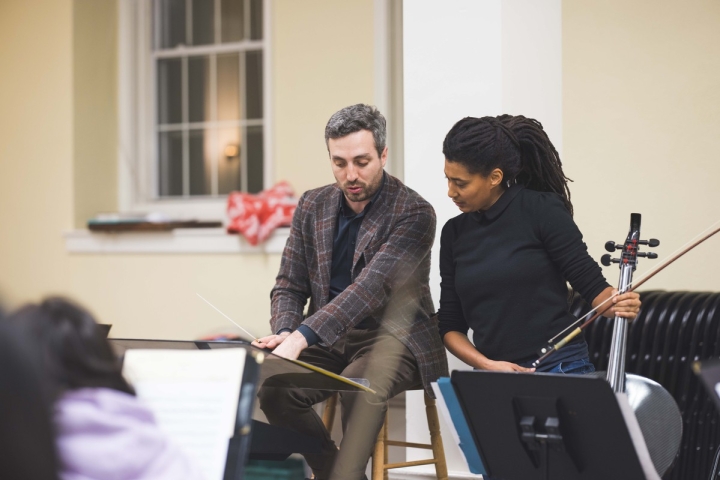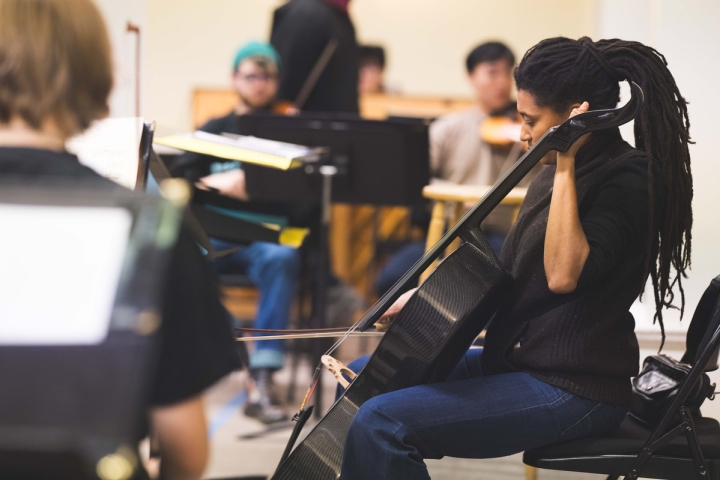When jazz cellist Tomeka Reid plays her composition Essay No. 1 on Saturday at Rollins Chapel as part of a Dartmouth Symphony Orchestra concert, it will be a chance for audiences to hear firsthand the distinctive sound—pulsating, urgent, and plangent—that has made Reid what the New York Times calls a “new jazz power source.”
Reid, who was named a 2022 MacArthur Fellow, is a Roth Visiting Scholar and artist-in-residence at the Hopkins Center for the Arts this year.
The DSO performance this weekend, directed by Filippo Ciabatti, will be only the second time Reid’s concerto has been publicly performed, she says. The first time around, Essay No. 1 had only 45 minutes of rehearsal.
For that reason, the Chicago-based Reid is “grateful that the DSO has been spending time on it,” a process which allows her to pinpoint “what things can I take out or put in, or leave as is, to get another experience of the piece.”
She also feels “fortunate to have the opportunity to solo with an orchestra. That’s not always the case.”
Reid, who formed the Tomeka Reid Quartet in 2015, has performed with such jazz heavyweights as the Art Ensemble of Chicago, flutist Nicole Mitchell, and saxophonists Anthony Braxton and Roscoe Mitchell. In 2013 she inaugurated the semi-annual Chicago Jazz String Summit, a three-day festival featuring leading string players from all over the world.
On April 11 Reid will debut at Rollins Chapel the Tomeka Reid Stringtet, an improvisatory 16-person chamber orchestra of musicians from New York and Chicago that will be conducted by Taylor Ho Bynum, director of the Coast Jazz Orchestra at Dartmouth. “It’s such a rare event to have a 16-piece (string) ensemble improvising,” Bynum says.
There is a certain irony, Reid says, in first having learned the classical cello growing up outside Washington, D.C., where some teachers told her that she would never be a soloist, and then mapping her own route into jazz, which hasn’t been conventionally thought of as a home for the cello.
“And here I am,” she says.
For Bynum, a longtime collaborator and friend, Reid is “an extraordinary embodiment of the Black creative music tradition that goes back over a century (in the U.S.). … She is conscious of spotlighting and celebrating that legacy.”

Reid’s range and technical and creative abilities on the jazz cello make her one of the “preeminent folks in establishing a vocabulary on that instrument,” Bynum says.
Beyond that, he added, Reid is known as an artist who “works to support a larger community,” which includes the Dartmouth students she has worked with since starting her residency in the fall. Reid’s residency also represents another milestone in the history of jazz and experimental music at Dartmouth, which has a decades-long history that deserves to be better known, Bynum says.
Supported with funds provided by former Dartmouth trustee Steven Roth ’62, Tuck ’63, his wife, Daryl, and their family, the Roth Visiting Scholar Award is intended to bring exceptional leaders across a variety of disciplines to campus. The Roth award has made it possible for Reid to enrich the Dartmouth community through the sharing and development of her own work in collaboration with students and faculty.
Encouraging students to experiment and improvise, and to fail and start over, is at the core of Reid’s approach to teaching. That kind of exploration, she says, is “something I wish I had experienced when I was learning—to play with your teachers, to feel what that feels like, even if you’re not at that level, to feel that sensation. A lot of it is doing, and doing things with them.”
Reid began her musical life by studying the classical music repertoire for the cello. But as she progressed, she noticed that some teachers painted a bleak picture for students who wanted to be professional musicians, telling them that the odds of making it a career at the higher levels were slim. Reid recalls thinking, “why do you have this music program if you’re not going to be encouraging?”
But creating a new kind of music with the cello had its challenges. People told her that if she moved into jazz, she wouldn’t be able to play classical music, or they assumed she didn’t have the technical chops to play it, “even if most of our pedagogy is coming out of classical music,” she says.
And Reid began to balk at having to always play the music exactly as scored. “That’s what was important instead of, what do I think about it? Maybe I just like that interval or that sound, you know?”
Some people wagged their fingers when Reid began inventing her own kind of music. “But I just started not caring so much because I was having so much fun doing the other stuff,” Reid says.
There was the additional barrier of being a woman in jazz, which has more than its share of great female musicians and performers, but, like other creative fields, has a history of sexism, harassment, and racism.
Reid felt that the “freer, more open stuff was more open to women,” and she took inspiration from other female Chicago musicians who had found their own way, making music as they wanted to, she says.
The cello gives her an enormous range for experimentation. It can occupy the range of the bass, but can also go high into the violin range, making it quite a versatile instrument; and its sound can be expanded by the use of pizzicato (plucking the strings) and other techniques, she says.
“It allowed me to be not so judgmental about what is a ‘good’ sound and what is a ‘bad’ sound but to take all the sounds and think of them equally and say, ‘I want to employ this sound here, or that sound there.’”
A musician is always reacting and responding—to the other musicians, to a conductor, to the audience. “I’m always learning from these different environments, and they’re always pushing me out of my comfort zone. Something I feel I learned in this music is finding comfort in discomfort, so you’re ready for whatever comes your way,” Reid says.
That ability to pick up on nuance and to read other musicians’ cues, in addition to her technique, gives Reid a particular kind of power, says Daniel Lin ’23, a cellist who played with Reid when she performed with the Coast Jazz Orchestra in its fall concert.
“A lot of the way she plays her cello I have not seen or heard before. She does it with a clarity of her idea. Every movement feels so intentional, all of it based on what other people are doing around her,” Lin says.
“I like to create happenings that bring people together and I like to share with the students. I like to be the teacher that I wish I had,” Reid says. Which includes going outside the range of what is expected.
“I love Shostakovich, I love Beethoven but I also love Curtis Mayfield and DeBarge. I love all this music. It didn’t seem fair that ‘this is music,’ and this is something else. No, it’s all music. I like that this ethos is there. It’s all valuable. It’s all important,” Reid says.
***
The Dartmouth Symphony Orchestra, directed by Filippo Ciabatti and featuring violinist and avant-garde composer Jessica Pavone and Roth Visiting Scholar Tomeka Reid, performs at 8 p.m. on Saturday, Feb. 17, at Rollins Chapel. The DSO will also play Mendelssohn’s Symphony No. 3 (“Scottish”) and When the World Changes Around You. Tickets are $25 and up. There is a pre-show discussion with Ciabatti that is open to the public in Baker-Berry Library.
On April 11, Tomeka Reid will debut the Tomeka Reid Stringtet in performance at 7:30 p.m. at Our Savior Lutheran Church in Hanover. Taylor Ho Bynum conducts. Tickets are $30 and up.

